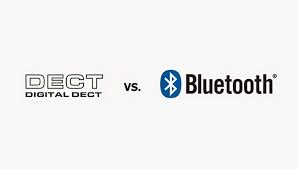DECT and Bluetooth Understanding the Difference

Understanding the Difference Between DECT and Bluetooth
In today’s world, wireless technology is a cornerstone of our daily lives. From the smartphones in our pockets to the wireless headsets we use for calls, understanding the technologies behind these devices can help us make informed choices. Two prominent wireless technologies you might encounter are DECT (Digital Enhanced Cordless Telecommunications) and Bluetooth. Though both serve to wirelessly connect devices, they operate in distinct ways and are suited for different applications. Let’s dive into the differences between DECT and Bluetooth.
1. Purpose and Use Cases
DECT was originally designed for cordless telephony, making it an ideal choice for home and office telephones. Its primary purpose is to provide a stable and clear voice communication channel over a range of up to 300 meters (about 1,000 feet). This makes DECT a popular choice for wireless landline phones and business phone systems.
Bluetooth, on the other hand, was created to facilitate short-range wireless communication between devices such as smartphones, tablets, and headphones. Its main strength lies in its versatility, supporting a wide range of applications from audio streaming to data transfer. Bluetooth typically works effectively within a range of 10 meters (about 33 feet), which is suitable for personal area networks.
2. Frequency and Interference
DECT operates on the 1.9 GHz frequency band, which is relatively less congested compared to other frequencies used by wireless devices. This helps minimize interference from other electronic devices. The 1.9 GHz band is also used exclusively for DECT communication, ensuring that it’s not shared with other wireless technologies.
Bluetooth operates in the 2.4 GHz frequency band, which is the same band used by many Wi-Fi networks and other wireless devices. As a result, Bluetooth can be more susceptible to interference from these other devices. However, Bluetooth includes mechanisms to handle interference, such as frequency hopping, which rapidly switches frequencies to avoid conflict with other signals.
3. Range and Connectivity
DECT’s longer range of up to 300 meters makes it ideal for larger spaces where reliable communication is needed. It can maintain a stable connection across a sizable area without the need for frequent re-pairing or manual intervention. This is particularly useful in office environments or homes with multiple floors.
Bluetooth’s range is significantly shorter, typically around 10 meters. While this may seem limiting, it’s designed for close-range interactions where devices are usually within arm’s reach. This short-range connectivity is perfect for personal devices like wireless headsets, keyboards, and mice.
4. Power Consumption
In terms of power consumption, DECT is generally more energy-efficient compared to Bluetooth. DECT devices are optimized for voice communication and have low power consumption when idle. This efficiency contributes to longer battery life in cordless phones and other DECT-based devices.
Bluetooth technology, especially in its modern iterations (like Bluetooth Low Energy), has made significant strides in power efficiency. Bluetooth Low Energy (BLE) is designed for devices that require minimal power for periodic data transmission, such as fitness trackers and smartwatches. Despite this, Bluetooth devices still need to manage power consumption carefully, particularly for continuous data streaming.
5. Data Transfer and Communication
DECT primarily focuses on voice communication, providing high-quality audio for phone calls. Its data transfer capabilities are limited compared to Bluetooth, making it less suited for tasks like file transfers or streaming media.
Bluetooth, however, excels in data transfer and supports a wide range of profiles for different applications. From transferring files and streaming audio to connecting peripherals and communicating with smart devices, Bluetooth’s versatility makes it a more adaptable technology for various needs.
In summary, DECT and Bluetooth are both valuable wireless technologies, each suited to specific use cases. DECT’s strength lies in its range and efficiency for voice communication, making it ideal for telephony. Bluetooth, with its versatility and short-range connectivity, is perfect for a broad spectrum of personal devices and data transfer needs. Understanding these differences can help you choose the right technology for your wireless communication needs, whether it’s for home, office, or on-the-go.

